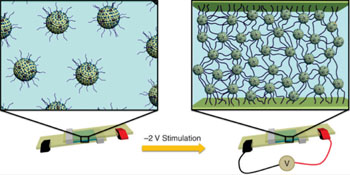Innovative Surgical Glue Hardens with Voltage
By HospiMedica International staff writers
Posted on 02 Sep 2015
A biocompatible glue that hardens once an electrical current is applied to it could be used to patch internal body tissues together in just minutes.Posted on 02 Sep 2015
Developed by researchers at Nanyang Technological University (NTU; Singapore) and Zhejiang University (Hangzhou, China), the appropriately dubbed Voltaglue is intended for a host of wet environment applications, from making underwater repairs for ships and oil rigs easier, and up to serving as a versatile tool for surgeons. The glue is based on hydrogels consisting of carbene molecules grafted onto polyamidoamine dendrimers, which are dissolved in aqueous solvents to form viscous gels. Upon contact with electricity, the reactive carbenes cross-link the dendrimer projections.

Image: Voltaglue curing under mild electrical current (Photo courtesy of NTU).
The hardness of the glue can be adjusted through the amount of time voltage is applied, a process called electrocuring. For example, if metal panels need to be glued underwater, it has to be hard, and thus will receive prolonged electrocuring; for medical applications, the glue needs to be more pliable to avoid damage to surrounding soft tissues. Another distinct feature of the new glue is that it could be made reversible, and thus easily recycled, reused, or remanufactured into new parts and components so as to reduce waste and energy consumption. The study was published on August 18, 2015, in Nature Communications.
“Most glue in the market don’t work under wet conditions, much like how sticky tapes won’t work if the surface is wet, since the adhesive will stick to the water instead of the surface,” said lead author Prof. Terry Steele, PhD, of the NTU school of materials science and engineering. “Our findings open a new class of electrocuring, on-demand, adhesive that allows tunable material properties and new development on substrates that are not currently possible with photo or thermocuring adhesives.”
Chemical-curing adhesives (CCAs) are a popular a joining technique in the manufacture of medical devices, in automotive industries, and in consumer goods. The main advantage of CCAs is that they combine inherent adhesive advantages with the advantages of instant fixation. However, most current CCA technologies need to be activated by either temperature, light (photoadhesives), or two-part thermosets (such as epoxy), all problematic in the medical setting. Snap-cure adhesives (such as methyl/ethyl-cyanoacrylate), form very strong substrate bonds, but their handling is difficult, and the bonding process cannot be end-user activated.
Related Links:
Nanyang Technological University
Zhejiang University














